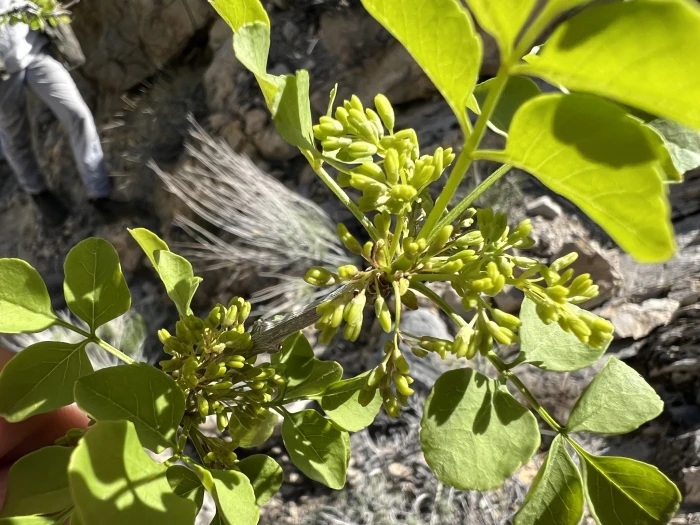Single-Leaf Ash
(Fraxinus anomala)
Single-Leaf Ash (Fraxinus anomala)
/
/

Steve Matson
CC BY 4.0
Image By:
Steve Matson
Recorded By:
Copyright:
CC BY 4.0
Copyright Notice:
Photo by: Steve Matson | License Type: CC BY 4.0 | License URL: http://creativecommons.org/licenses/by/4.0/ | Rights Holder: Steve Matson | Publisher: iNaturalist | Date Created: 2023-05-01T16:54:04Z |
























Estimated Native Range
Climate Requirements
| • Precipitation | 4" - 35" |
| • High Temp. | 65°F - 109°F |
| • Low Temp. | 3°F - 45°F |
Summary
Fraxinus anomala, commonly known as Single-leaf Ash, is a deciduous shrub or small tree native to desert scrublands, rocky hillsides, and canyons in the southwestern United States and northern Mexico. It is particularly adapted to arid environments and is often found in association with pinyon-juniper woodlands. This species typically grows to heights of 5 to 6 meters (16 to 20 feet) and has a rounded to irregular crown. The leaves are unique among ashes for being simple or only occasionally compound, with oval-shaped leaflets that may have serrated edges. The inconspicuous brownish flowers appear in spring and are not showy, but the tree is valued for its ability to thrive in challenging conditions. The fruit is a distinctive flat samara, up to 2 centimeters long, which aids in wind dispersal.
Single-leaf Ash is appreciated for its drought tolerance and ability to grow in poor, rocky soils, making it suitable for xeriscaping and naturalistic plantings in arid regions. It requires minimal maintenance once established and can survive with very little supplemental water. In cultivation, it prefers full sun to partial shade and is best planted in well-drained soils. While not commonly used as an ornamental, it can serve as a windbreak or for erosion control on slopes. There are no significant disease or pest issues, but it is not suitable for areas with high moisture or rich soils, as it may develop root rot.CC BY-SA 4.0
Single-leaf Ash is appreciated for its drought tolerance and ability to grow in poor, rocky soils, making it suitable for xeriscaping and naturalistic plantings in arid regions. It requires minimal maintenance once established and can survive with very little supplemental water. In cultivation, it prefers full sun to partial shade and is best planted in well-drained soils. While not commonly used as an ornamental, it can serve as a windbreak or for erosion control on slopes. There are no significant disease or pest issues, but it is not suitable for areas with high moisture or rich soils, as it may develop root rot.CC BY-SA 4.0
Plant Description
- Plant Type: Shrub, Tree
- Height: 8-20 feet
- Width: 4-15 feet
- Growth Rate: Moderate
- Flower Color: N/A
- Flowering Season: Spring
- Leaf Retention: Deciduous
Growth Requirements
- Sun: Full Sun, Part Shade
- Water: Medium
- Drainage: Fast, Medium, Slow
Common Uses
Drought Tolerant, Erosion Control, Low Maintenance
Natural Habitat
Native to desert scrublands, rocky hillsides, canyons, and pinyon-juniper woodlands
Other Names
Common Names: Singleleaf Ash, Dwarf Ash
Scientific Names: Fraxinus anomala, Fraxinus anomala
GBIF Accepted Name: Fraxinus anomala